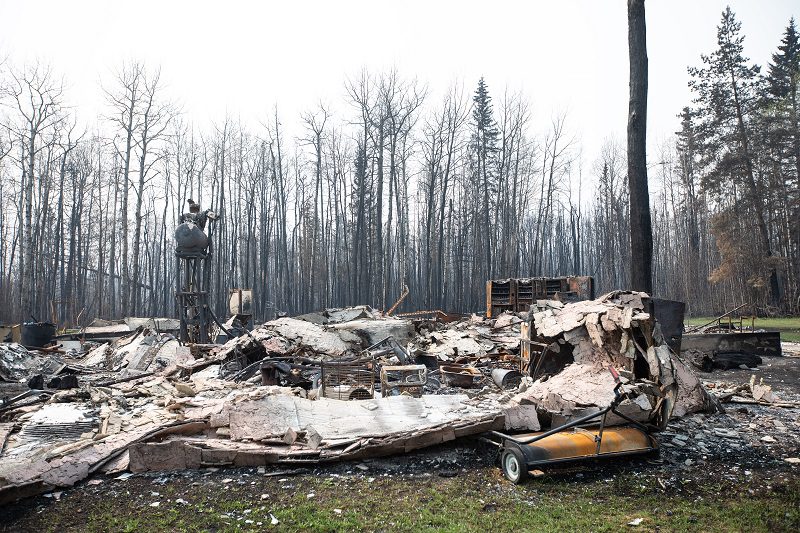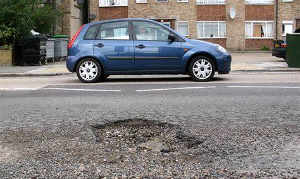Some residents return home two weeks after Alberta wildfire evacuation

The mayor of a west-central Alberta town said it was emotional to return home nearly two weeks after an out-of-control wildfire forced residents to flee, but thousands elsewhere remain on edge as scores of fires continue to rage across much of the West.
“Just happy to be home and happy to be supporting one another and just pulling together like we always do,” Drayton Valley Mayor Nancy Dodds told a news conference Wednesday.
Fire officials pointed to areas around the community, 145 kilometres southwest of Edmonton, showing how close the flames crept.
People hugged each other and employees at the local grocery store as shelves were being restocked. Virtually all of the store’s meat and dairy products left behind during the evacuation had to be thrown out.
“It’s a huge relief, and we’re just so thankful that our home is still standing and that everyone is OK,” said Jade Verheul, who had to quickly leave with her children on May 4.
Verheul said she was lucky to have a place to go because her parents have an RV lot in Seba Beach, west of Edmonton.
Rikki Smith was working at the town’s Boston Pizza when they were told to evacuate nearly two weeks ago.
“I got everybody out of here safely,” said Smith on her break. “That was my priority.”
The Boston Pizza was one of the only restaurants open in the town on Wednesday. Customers came in to greet the workers and were welcomed with open arms.
Police block the road into the wildfires near Entwhistle Alberta on Sunday May 7, 2023. THE CANADIAN PRESS/Jason Franson.
“Our community is very tight-knit and we love to support our community,” said Smith, adding that they were getting calls at 9 a.m. from residents asking if they would be open.
The mother of three said that after this evacuation, she’ll be more prepared for the next one.
“I’m worried that it could spark up again. I think that’s everybody’s worry,” said Smith. “You have to just be prepared for it … I don’t think we’re out of the woods completely.
“I think that we’re fortunate enough that we were able to come back when we were and that the community made it so that it was safe enough for us to come back when we did.”
Smith also works at the hospital in Drayton Valley and has been in town since Tuesday morning to prep the emergency room, which is now open.
“It’ll take some time, but it’s getting there,” said Smith.
Officials said five homes were destroyed by the blaze. A firefighter was also injured by a falling tree.
Fire Chief Tom Thomson said while the fire risk has eased significantly, people should take precautions.
“There are still extremely hazardous areas out in the county area. We call it the burn area or the black area. There are concerns about falling trees, there are concerns about ash pits,” he said.
More than 11,900 people in Alberta remain forced from their homes. Ninety-one active wildfires were burning in the province, with 27 listed as out of control as of Wednesday afternoon.
There are about 2,500 people battling wildfires in Alberta, including hundreds of soldiers.
Reservists trudged through smouldering trees near Drayton Valley on Tuesday before officials partially lifted an evacuation order. Dressed in yellow jumpsuits with bright blue safety helmets, they walked through trees, some of which were reduced to matchsticks.
Officials said another firefighter was seriously injured battling a blaze near the East Prairie Metis Settlement in the north.
Hotter and drier temperatures are in the forecast and there’s a fire ban for nearly the entire province.
There were also 25 active wildfires in Saskatchewan as of Wednesday afternoon.
Buckley Belanger, a former long-serving legislature member in northern Saskatchewan, left Ile-a-la-Crosse after an evacuation was ordered for the village Tuesday. Ile-a-la-Crosse is on a peninsula and a single road connects it to the main highway.
Belanger said the wildfire travelled within 12 kilometres of the community and crossed the highway. He said the blaze is moving through the tops of trees and shooting pine cones like “vessels of fire.”
“The wind is helping push it in the direction of Ile-a-la-Crosse and we are hoping either rain comes or the wind shifts,” he said. “But we are clearly in its path. That’s why it’s better to get people out of harm’s way.”
People were also forced to flee nearby Buffalo Narrows this week. Belanger said more than 30 cabins were likely destroyed. The loss is devastating, he said, as the buildings hold rich family and trapline history.
“We see all that burned to the ground, nothing left but ashes,” Belanger said. “That’s real, real heartbreaking.”
The Saskatchewan Public Safety Agency said it’s supporting 329 evacuees with accommodations and meals in Lloydminster, North Battleford and Regina.
The agency said it has not received reports of any structures being destroyed and that none of the fires are directly threatening communities.
The agency said it aims to make sure food and fuel are delivered to northern communities that have not evacuated. The main highway into those communities has closed and only essential travel is allowed.
Air quality statements continue to blanket most of Western Canada.
Meanwhile, the City of Fort St. John in northeastern British Columbia has rescinded its evacuation alert, as a change in wind direction aided firefighters in preventing two out-of-control wildfires from advancing closer.
An update on the city’s website says the alert has been lifted for all properties and its roughly 21,000 residents “can safely resume everyday activities.”
Dan Davies, the legislative member for Peace River North, said the smoke is heavy in the area.
“You can’t see a couple blocks away,” he said.
In the Northwest Territories, the K’atl’odeeche First Nation and town of Hay River, about 120 kilometres from the Alberta boundary, remain evacuated.
Mike Westwick, a wildfire information officer with the government, said a small amount of scattered showers provided a crucial opening for firefighting teams to tackle the blaze. But he said the relief would not last as hot, dry weather continues.
– With files from Emily Blake in Yellowknife and Jeremy Simes in Regina
Feature image: A structure destroyed by recent wildfires is shown in Drayton Valley, Alta. on Wednesday May 17, 2023. Air quality statements continue to blanket much of British Columbia and the Prairie provinces as scores of wildfires rage across the region. THE CANADIAN PRESS/Jason Franson



